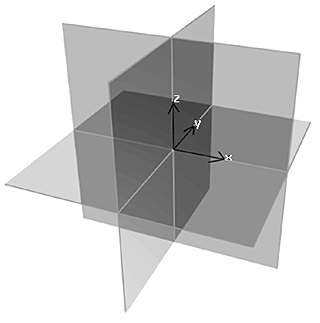The grid you see in each viewport represents one of three planes that intersect at right angles to one another at a common point called the origin. Intersection occurs along three lines (the world coordinate axes: X, Y, and Z) familiar from geometry as the basis of the Cartesian coordinate system.

Using the home grid to position houses
The three planes based on the world coordinate axes are called the home grid; this is the basic reference system of the 3D world.
To simplify the positioning of objects, only one plane of the home grid is visible in each viewport. The figure shows all three planes as they would appear if you could see them in a single perspective viewport.

Home grid axes and planes
Two axes define each plane of the home grid. In the default Perspective viewport, you are looking across the XY plane (ground plane), with the X axis running left-to-right, and the Y axis running front-to-back. The third axis, Z, runs vertically through this plane at the origin.

Above: Inactive grid object in a scene
Below: Activated grid object
The home grid is aligned with the world coordinate axes. You can turn it on and off for any viewport, but you can’t change its orientation.
For flexibility, the home grid is supplemented by grid objects: independent grids you can place anywhere, at any angle, aligned with any object or surface. They function as "construction planes" you can use once and discard or save for reuse. See Precision and Drawing Aids.
The AutoGrid feature lets you create and activate temporary grid objects on the fly. This lets you create geometry off the face of any object by first creating the temporary grid, then the object. You also have the option to make the temporary grids permanent. See AutoGrid.